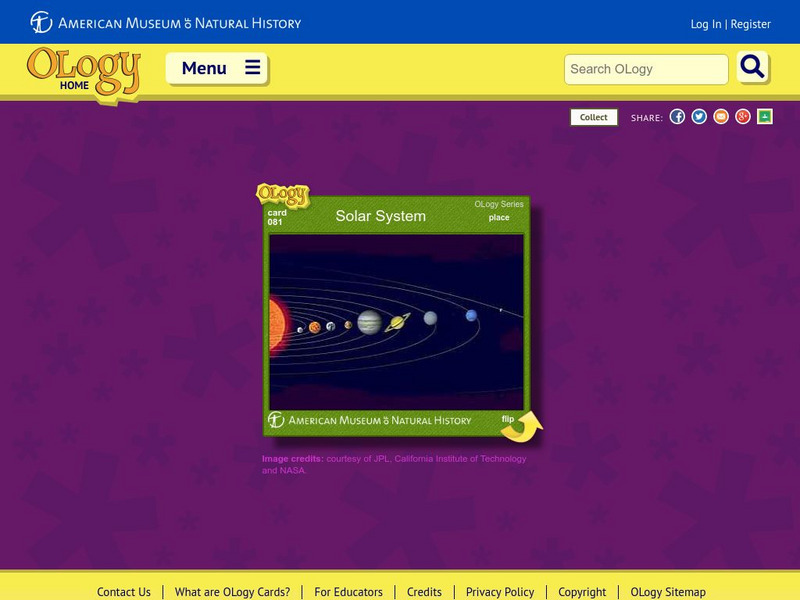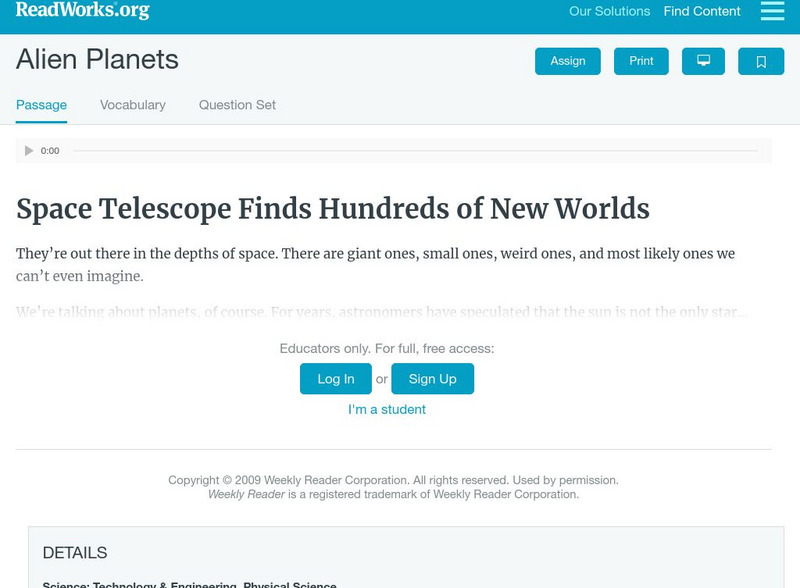NASA
Nasa: Planets in a Bottle
In this simple lesson, students grow yeast to learn how the climates on each of the nine planets would affect life.
American Museum of Natural History
American Museum of Natural History: Carl Sagan and the Quest for Life in the Universe
A brief biography of American astronomer and science advocate Carl Sagan.
TeachEngineering
Teach Engineering: Space Shelter
The invasion has taken place and we need to find a new home. To ensure your survival beyond earth's occupation you must design a shelter that can be built on another planet. Students will research the characteristics of a planet of their...
TeachEngineering
Teach Engineering: The Outer Planets
Young scholars explore the outermost planets of our solar system: Saturn, Uranus and Neptune. They also learn about characteristics of Pluto and its interactions with Neptune. Students learn a little about the history of space travel as...
CK-12 Foundation
Ck 12: Earth Science: Formation of the Sun and Planets
[Free Registration/Login may be required to access all resource tools.] How the Sun and planets formed.
NASA
Nasa: Space Place: Messenger: Planet Mass Comparison
Compare the masses of planets in this interactive animation. Simply pile a number of Earths on one side of the scale, to balance with the mass of one Jupiter. Then try this with all the planets.
American Museum of Natural History
American Museum of Natural History: Solar System O Logy Card
Here's an Ology Card about the Solar System, offering a small image, a definition, and information on how "far out" our Solar System is. Includes questions to quiz your knowledge and quick facts about the Solar System's size, rotation...
American Museum of Natural History
American Museum of Natural History: Venus O Logy Card
Flip this interactive card to start learning about the planet Venus. Answer multiple-choice and fact-or-fiction questions and review some fast facts about Venus.
Nine Planets
The Nine Planets: Venus
In-depth information site on Venus, complete with a thorough glossary, links to a wide array of related sites, thumbnail picture files linked to larger images, and even a short audio file from a classic symphony.
NASA
Nasa: Sci Jinks: How's the Weather on Other Planets?
Compare weather here on Earth to other planets and moons in our solar system. You will find many similarities and differences.
Read Works
Read Works: Alien Planets
[Free Registration/Login Required] This nonfiction piece discusses the discovery of previously unknown planets in the solar system. This passage is a stand-alone curricular piece that reinforces essential reading skills and strategies...
Read Works
Read Works: A New World!
[Free Registration/Login Required] This informational text passage describes the exoplanet named Gliese 581c in the solar system. This passage is a stand-alone curricular piece that reinforces essential reading skills and strategies and...
National Earth Science Teachers Association
Windows to the Universe: Our Solar System
Our solar system is filled with a wide assortment of celestial bodies - the Sun itself, our eight planets, dwarf planets, and asteroids - and on Earth, life itself! The inner solar system is occasionally visited by comets that loop in...
Nine Planets
The Nine Planets: Uranus
An excellent report on the planet Uranus. The site includes detailed information about the planet as well as links to information about Uranus moons, unmanned probes sent to explore Uranus, and an extensive set of images of the planet.
Sophia Learning
Sophia: The Solar System
A podcast explaining a model of the solar system which students can visualize, or even try to recreate. [1:38]
Exploratorium
Exploratorium: Your Age on Other Worlds
Enter your birthday and find out how old you are on the other planets in the Milky Way Galaxy. Understand why our age is different on each planet.
Soft Schools
Soft Schools: Space: Solar System Interactives
Identify the planets in our solar system and discover how much you weigh on another planet with these space interactives.
NASA
Nasa Star Child: Uranus, Neptune's Twin (Level 1)
Get to know the twin of Neptune with this introduction to Uranus. Listen to the information in an audio file. Features include a printable version of the page, and vocabulary words are linked to a glossary of terms.
NASA
Nasa Star Child: The Solar System
Discover information about parts of the Solar System, along with definitions just by clicking on highlighted vocabulary terms. Be sure to try the "Solar System Activities" to review the material from these pages.
A&E Television
History.com: The Space Race: Interactive Universe
A virtual journey through space offers photos and facts about Earth and its neighboring planets, comets, other celestial bodies of the Solar System, and the Milky Way and Andromeda galaxies.
Physics Classroom
The Physics Classroom: Mathematics of Satellite Motion
The mathematics associated with the motion of satellites is described. Equations (for period, velocity, acceleration and force) are stated, symbols described, and sample problems solved. Includes five practice problems with solutions and...
Physics Classroom
The Physics Classroom: Kepler's Three Laws
The three laws of planetary motion as described by Kepler are stated and elaborated upon. Useful graphics and an easy-to-understand language are used to explain the nature of planetary motion. Both conceptual and mathematical. Includes a...
Georgia State University
Georgia State University: Hyper Physics: Kepler's Laws
An outstanding page describing Kepler's three laws of planetary motion.
Space Telescope Science Institute
Nasa: Hubble Traveling Exhibit: Planets
At this site from HubbleSite you can learn everything you wanted to know about planets like what is the weather on Mars, what is the black eye on Jupiter? Site also provides links to information on the telescope, the rest of the planets,...




















